At the back end of 2024, most developers at this point are using some sort of LLM AI assistance in their coding practice. For some this might be Github Copilot integrated into their IDE at work, for others this may be the use of Claude or V0 for first draft code origination, or it may be as mundane as using ChatGPT or Gemini for error clarification and debugging support. Software engineers are mostly considering AI a net benefit, helping them be more productive.
This suggests that developers are, by and large, internalising the idea of AI as a tool rather than a competitor. Also, developers are reinforcing their belief that their value is less about lines of code produced and more about the outcomes as a result of the problems solved.
Software engineering has always had problem solving as its primary function, however, in the period of extreme digitalisation through the late 1990s to mid 2010s, development started being seen by many parts of business as a volume play. Lines of code produced and numbers of errors in production became the criteria for success. Teams were measured on output against cost - leading to waves of outsourcing, then offshoring, as code was treated as a manufactured good. All the while businesses needed rapid process digitisation, volume of output was the primary goal.
But this came at a price.
As we reach the midpoint of the 2020s, many organisations are dealing with huge amounts of complexity, lack of explainability in their code bases (especially with legacy code), and there are still systemic skill shortages of software engineers in most markets, notwithstanding some of the big-tech layoffs.
A software engineer is someone who looks both ways - even when crossing a one way street.
AI assisted development can help us keep pace with the volume aspects of modern software engineering, however, as developers we are better utilised thinking about and solving problems conceptually and spending less time cranking out code. The code is the byproduct of solving the problem not the other way around.

Typically, most engineers write a quick sketch of what they want to do before they start to write code in a rough form called pseudocode. Every knowledge worker engages in this process to some extent, as dictated by the medium of their work. This could be a dot point outline for a writer or strategist, a literal set of sketches for a director or cinematographer, or a set of unstyled slides by a manager creating a presentation.
The method may change, but the purpose is the same. By sketching something out conceptually, you think through the core problem you are trying to solve - whether that’s telling a story, building the arguments of a business case, or structuring the logic of a program. This is done before getting stuck into the low level detail that necessarily entails a great deal of implementation messiness (or, in the case of powerpoint, time spent nudging and styling).
For inexperienced or learning developers (as with most skill-based professions) this transition from high level conceptual thinking to low level implementation can be tricky. Knowledge and experience both play a part in this but ultimately you need to get from a concept like “add the product into the user’s shopping cart” to the nitty gritty details of how to do that in the system and language you are working with. This step is challenging because you need to map the problem definition (what do I want to do?) to the capabilities of the tool you’re going to use to do it (how does my programming language allow me to implement this?).
Even for experienced developers, there is cognitive load involved in this activity that creates friction in the process - not least when you need to read some pre-existing code and then turn that into a conceptual map in your mind about what the code is doing in the system before you can tackle the problem at hand.
LLM AIs can assist this process because, fundamentally, they are language tools. This means if I ask an LLM to write me some code that meets some criteria such as “build a javascript function that takes two numbers and adds them together”, it can do a pretty good job of translating that into something that works (or works well enough). This is why a lot of junior developers have jumped headfirst into using LLMs to support their development as it allows them to pose a task and get an answer. More experienced developers use the same tooling - but with more direction - to get the LLM to produce the boilerplate code they know they will need and then assume that they will fill in the details.
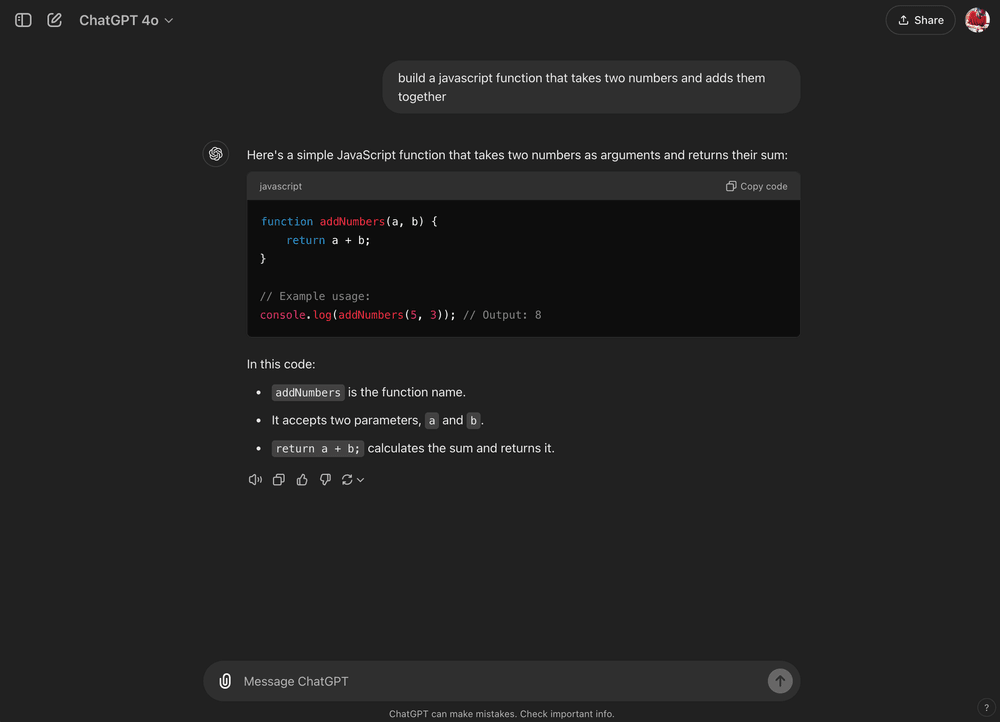
Both of these approaches work and have lead to some productivity increases for some teams (at least for routine work).
The AI tools we have available to us now are fairly capable for boilerplate code or specific task generation (eg Copilot), but they are limited in bridging the gap between concept and implementation. New reasoning models like o1 or techniques like Chain of Thought bring this a step closer, however they are really just improving task adherence and completion rather than mapping from concept to implementation.
Current AI tooling does provide non-trivial incremental improvement to developer productivity however they remain reactive - focussing on filling gaps in code rather than helping engineers structure and think about the solutions at the conceptual level. Inherently, this limits their potential impact - especially in more complex projects that solve real problems where the challenge is in bridging between the idea and execution.
Could we do better?
If we assume we have good enough LLM AIs available to us, and they can be sufficiently integrated into our work systems, could we reimagine the way we shift between high level concepts about a system and the low level implementation of the system? Could we integrate LLMs not just to help with code generation but also maintain a bidirectional relationship between pseudocode and executable code, increasing both developer productivity as well as software quality?
The elements I outline below might give us some of the steps we need to get us closer to realising some of these opportunities.
Pseudocode - a structured method for thinking
In a ground floor classroom with steel security bars across the windows and a double-lock door that was nearly always shut, I sat through my first formal computer science lessons. In the early 1990s, my school was lucky enough to have an actual “computer lab” - a vault-like room I found myself in a couple of times a week from year 9 through to completion in year 12 (not accounting for the time spent sitting in the corridor after been thrown out of that room for being a “difficult” student, but that’s another post). Packed with 25 Apple PCs, it was here we would take the work we had been doing in theory in a regular classroom during our other computing lessons and apply it to actual computers in the lab.
The vast majority of my classmates didn’t have computers at home. At this point, it was still rare to have a computer - some families had a games console, but that was it.

As a result, teachers couldn’t expect a student to have ready access to a computer to write code. This provided my, and my classmates’ introduction to pseudo code and structured logic. Computing being seen as part of mathematics, it directly built on the logical reasoning skills we were taught in maths lessons.
By using pseudocode, teachers could ensure some degree of equity in a period of unequal access, and also made things relatively easy from a homework and assessment standpoint. Instead of programming a function to take two numbers and add them together you would write out that function in pseudocode on a piece of paper. Bad handwriting aside, it would have made marking pretty straightforward for a teacher too.
As you can see below, there is a little bit of structure to pseudocode, and it vaguely looks like a programming language. It’s just a series of statements allowing you to express some logic. Even today, developers and teams rely on similar approaches to think through how they will tackle a problem conceptually.
Function AddNumbers(a, b):
result = a + b
return result
- get the first number from input and assign to variable A
- get the second number from input and assign to variable B
- call the AddNumbers function with A and B and print the resultWhen we had access to the lab, our job would be to turn our pseudocode into Basic and see how well it functioned. By having the structure of our approach already well thought through, it was feasible to write the code in Basic during a lesson period and see if it worked - thus beginning to anchor the relationship between problem solving concept and the code that implements it.
10 INPUT "Enter the first number: ", A
20 INPUT "Enter the second number: ", B
30 GOSUB 100
40 PRINT "The sum of the two numbers is: "; RESULT
50 END
100 REM Subroutine to add two numbers
110 LET RESULT = A + B
120 RETURNUsing pseudocode, teachers provided a bridge between logical reasoning and programming implementation. While this was driven from necessity, it was a good way to build logical reasoning and conceptual thinking skills in students.
As I left school and went to uni, my computer science courses built on this further by teaching algorithms and formalised ways of reasoning about them in terms of complexity, performance and accuracy. These formal methods were anchored to programming in Pascal which maps very well to structured pseudocode and is remarkably readable (before ultimately we were moved on to C which is decidedly less readable). As we started building more complex applications, the core methods remained, and were used much as they are today - work through the logical approach before sitting down to write the code.
program AddTwoNumbers;
function AddNumbers(a, b: Real): Real;
begin
AddNumbers := a + b;
end;
var
num1, num2, result: Real;
begin
Write('Enter the first number: ');
ReadLn(num1);
Write('Enter the second number: ');
ReadLn(num2);
result := AddNumbers(num1, num2);
WriteLn('The sum of the two numbers is: ', result:0:2);
end.The benefit of teaching like this is that you focus on the problem solving part of the learning. You force the learner to think through the problem and break it down into tasks, each of which can be broken down further. You also largely remove syntax as a concern. As you can see, the jump from pseudocode to Basic or Pascal brings with it additional syntactical structure, and these become places where a learner fails - a missed semicolon in Pascal or a jump to the wrong line number in Basic brings the program to a halt for example.
The counter argument for this method of teaching is that it is astonishingly dry. Formalised reasoning has its place, but being structured around the formal, mathematical roots of computer science can be off putting. Additionally, as computers became considerably cheaper and more accessible to students, there was a desire to move more towards “getting outcomes” and learning logic as a byproduct of the process. This was in part driven by the goal of industry and government to produce “coders” not “computer scientists”.
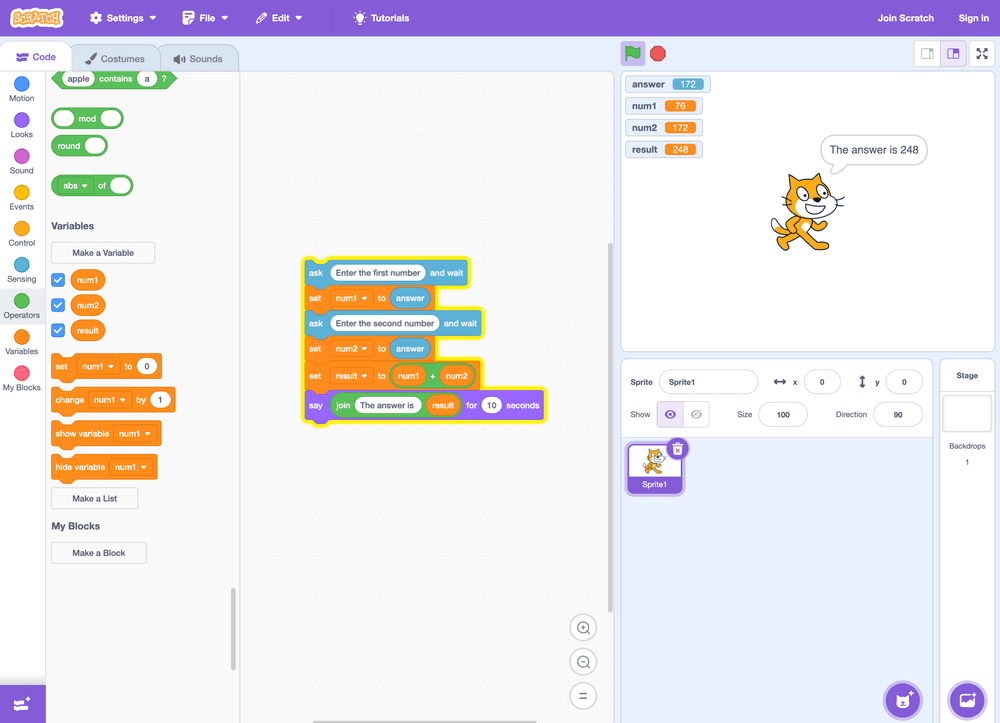
Using visual programming environments like Scratch or high level pseudocode-like programming languages like Python, this approach took off. Learners could jump right into an environment that was easy enough to learn with few syntax quirks and then get a result - a cat that moves around a screen in Scratch, or a program to interactively guess a number in python.
The errors one experiences in getting an environment up and running or when the code fails are all considered part of the learning process to help the would be programmer learn how to debug as they graduate to bigger systems.
This process is less formal, but over time builds logical concepts and hopefully keeps more people interested, allowing them to transition into considering programming as a career.
Regardless of the way one learns to think through concepts, structured thinking remains fundamentally at the heart of all knowledge work and it is particularly useful for development.
As teams work together, we use these methods of structured thinking to collaborate. In most multidisciplinary teams, only a small fraction of those in the team are software engineers wiring code. Thus we use structured methods such as requirements documents or business process maps so we can communicate effectively and work through the fundamental concepts of what we’re seeking to achieve. This helps align vision and clarity across the whole team as you get into implementation.
Pseudocode is often a part of this process. As a software engineer goes through the requirements, she may use those requirements to sketch out an approach, which she shares with other engineers and team members who may add comments or refine the logical design. From there, she is likely to turn that pseudocode into comments in the first draft of some code and then start filling in details. Beginning with all the boilerplate code and then “stubbing out” functions or API calls she will implement later in more detail.
This process of increasing fidelity is an extremely common pattern and used across most knowledge workers. In late 2024, our software engineer above is probably also dropping some of that pseudocode into an AI code generator such as Github Copilot or ChatGPT, which is helping to produce the routine parts of the first draft code.
Using Github Copilot to build example code. Yes, I still use Vim. (cc) ajfisher
Pseudocode still serves as a valuable tool for structured thinking, however with the increasing complexity of modern software and the expanding capabilities of AI tools, there is an opportunity to rethink how we transition between conceptual problem-solving and writing code.
Coupled with AI tooling, pseudocode could be leveraged not just as a transitional step but as a bridge that allows us to move seamlessly between concept and implementation. But, can we push the tools to help developers spend more time thinking conceptually and code more effectively?
Bridging the concept to implementation gap
Even though most engineers will at least start with some form of pseudocode-like outline, potentially as comments in their files, as fidelity increases these comments begin to disappear. The initial comments likely get consumed into the implemented code and we lose some of the conceptual elements along the way.
A good team might maintain some solid comments that explain what the function or the code is doing, and even how it relates to the wider system. However, as the code ages, teams turn over, and more modifications are made, unless outstanding processes are maintained on code documentation, there is likely to be drift between meta commentary about the code conceptually and what the code is actually doing. Unfortunately, most developers are KPI-ed on clearing tickets and code shipped to production, not writing docs.

But what if we don’t drop down to the lower level in the first place?
What if, instead of just doing a sketch in pseudocode then transforming that into executable code, we wrote slightly more formalised and slightly more detailed pseudocode and used an LLM tool to do the conversion into the underlying programming language we want?
We are currently so used to google, we inherently treat LLM AIs as answer engines - that is “Can you write me a function in javascript that adds two numbers together?”
We’re only just working out the implications of how we use LLM AIs as language engines instead?
Style transfer lends itself well to programming
We’ve seen examples where an LLM converts text from one language to another (increasingly in voice as well). This form of style transfer lends itself well to programming languages because there’s just so much programming content on the internet. A number of programmers will take a function written in one language that they have copied online and ask an LLM to convert it to their preferred language. This isn’t new - but it is a powerful tool.
Say we baked into our development tools a layer that can take developer created pseudocode and then, in real time, the AI tool does the conversion into the lower level language.
For example, a developer might want to find the largest value in a list and so write out the pseudocode below:
function FindMax(array):
# Precondition: The array contains at least one element.
max = array[0]
# Loop Invariant: At the start of each iteration, max contains the
# largest element found so far in array[0..i-1].
for i from 1 to length(array) - 1:
if array[i] > max:
max = array[i]
# Postcondition: max contains the largest element in the array.
return maxWe've added some additional structure and using a more formalised notation with pre and post conditions to highlight expectations of how the function performs. We also use a loop invariant to provide clarity over our assumptions about what is happening inside the loop.
With such instructions, using today’s AI tools, a lot of this conceptual structure can get stripped out in the translation process. But, by preserving these comments and maintaining formal structures, LLMs could produce more readable and robust code.
An example of what that looks like with our future integrated AI development partner might be the JavaScript code below:
function findMax(array) {
// Precondition: The array must contain at least one element.
if (array.length === 0) {
throw new Error('Array must contain at least one element.');
}
// Initialize max with the first element of the array.
let max = array[0];
// Loop Invariant: max contains the largest element found so far in array[0..i-1].
for (let i = 1; i < array.length; i++) {
if (array[i] > max) {
max = array[i];
}
}
// Postcondition: max contains the largest element in the array.
return max;
}You can see the mapping easily enough because the LLM has kept the comments and the overall structure of the logic so this works pretty well. Even if I’m not a great JavaScript developer, I could take that code, try it out, and see if it worked. If I was a learner of the language, I could put the pseudocode and JS side by side and start to map the conceptual logical elements to the underlying language constructs quite effectively, improving my ability to understand what’s going on.
At this point we’re very much still in the territory of the current, albeit quite manual, processes that Generative AI tools support in 2024.
To take this further though, as the developer writes the pseudocode, the LLM could provide realtime feedback, making recommendations or highlighting gaps in the logic that need improvement. For example, the AI may suggest making improvements to the original pseudocode to check for valid numbers and to handle edge cases more gracefully such as the example below:
function FindMax(array):
# Precondition: The array contains at least one element.
if length(array) == 0:
throw Error("Array must contain at least one element")
max = array[0]
# Precondition: The first element must be a valid number.
if not IsNumber(max):
throw Error("All elements in the array must be valid numbers")
# Loop Invariant:
# At the start of each iteration, max contains the largest element found
# so far in array[0..i-1].
for i from 1 to length(array) - 1:
# Precondition: Each element must be a valid number.
if not IsNumber(array[i]):
throw Error("All elements in the array must be valid numbers")
if array[i] > max:
max = array[i]
# Postcondition: max contains the largest element in the array.
return maxAs a learner, this gives insight to instruct me on best practices I should adopt as I learn to program. For a more experienced developer, these are all things I’d have most likely done anyway - even if I’d have glossed over them in my sketch - because they are good practices. Now I can be more explicit about what code I want to produce.
With this structure, the LLM assistant could construct test cases based on the pseudocode and as the produced code, supporting a rapid, iterative, test driven development approach such as that below (snipped for brevity to just a few cases):
// Test case 1: Typical case with positive numbers
try {
console.log(findMax([1, 3, 5, 2, 4])); // Expected output: 5
} catch (error) {
console.error(error.message);
}
// Test case 2: Empty array (should throw error)
try {
console.log(findMax([])); // Expected output: Error "Array must contain at least one element"
} catch (error) {
console.error(error.message);
}
// Test case 3: Array with non-number elements (should throw error)
try {
console.log(findMax([1, 2, 'three', 4])); // Expected output: Error "All elements in the array must be valid numbers"
} catch (error) {
console.error(error.message);
}Having this joined up way of working allows the developer to think logically and algorithmically to solve the problem at hand and relies on the LLM to provide the immediacy of being able to create and run executable code then get feedback. Some IDEs support aspects of this, but having it fully integrated such that the developer primarily interacts with the logical layer and then gets real time feedback and executable code iteration at the same time would be a benefit for learners and experienced developers alike.
The developer may need to start to handle edge cases or fill in
specific details about how APIs are called - especially if they are internal.
At this stage, they will probably want to make edits to the underlying
produced code to carry it forward. In our example above we might need to add
specific checks to ensure the function is called with an Array of items, or the
array has an item that contains Infinity.
All this being said, as a byproduct of this process, the developer will also produce an artefact that represents the logical approach for the code they have produced - which can be stored and referenced by themselves, or others. This could even be consumed by other systems such as documentation generators to derive secondary high value assets.
This approach has particular benefits for learners as it links together the structured thinking (what I want to do) with an immediacy of outcome (I can see it doing). This allows a learner to scaffold their knowledge as it directly ties the algorithm back to the code that is produced. As mentioned above, having a feedback mechanism can support illustration of best practices which the learner can see implemented in a way that would normally occur by working with a more senior engineer or through code review. In situations where an inexperienced developer is working or learning solo (eg at school or in a very small team) this feedback mechanism would actively support their learning process and help prevent them from developing bad habits.
Aspects of this exist in 2024 in some IDEs already, as well as developers manually throwing code snippets or lists of requirements at ChatGPT or Gemini and getting some code back. However, in most cases this process is disconnected and misses a lot of context. Invariably, it involves a lot of copying and pasting between applications to make it work(ish).
Workflow challenges aside, this process does work and I know a number of developers who use these LLM features to enhance their learning or improve productivity by doing exactly the techniques above.
A more integrated approach would undoubtably speed this process up, but assuming we had a tightly integrated development environment, we could take this idea even further.
With the right integration, this process could go beyond just generating code - it could create a dynamic, realtime collaboration between developers and AI, allowing both to operate effectively at multiple levels of abstraction. An idea of what this might look like is what we’ll explore next.
Realtime, bidirectional human-AI collaboration
Developers spend a lot of time reading code - many times the amount of time spent writing it.
Guido van Rossum, creator of the Python programming language observed, “Code is read much more often than it’s written” - leading him to many of the design decisions that underpin the core concepts of the language. As a result, Python is probably the most readable programming language we have available for general purpose programming.
Even acknowledging the readability of Python code is generally outstanding, anyone trying to wrap their head around an uncommented list comprehension for the first time will likely struggle to understand what is going on. Take for example the snippet below:
people = [("Alice", 22), ("Bob", 17), ("Charlie", 18), ("David", 15), ("Eva", 30)]
adults_uppercase_names = [name.upper() for name, age in people if age >= 18]
print(adults_uppercase_names) # Expected output: ['ALICE', 'CHARLIE', 'EVA']The centre line, even with good naming, may be difficult for non Python programmers to understand. In one very terse line that code:
- goes over the data that is in the list of people noting that the name is always the first item and the age is the second item in each set.
- If the age part is greater than or equal to 18 then keep those elements, throw everything else out.
- For those people that are left, take the name and convert it to uppercase.
- Assign the uppercase names as a list to the adults_uppercase_names variable.
That’s quite a lot of things happening in one very short line of code.
Once you understand the structure, it is relatively straightforward to see what’s going on, but it’s also ripe for being incomprehensible. I’ve seen some extremely clever Python list comprehensions over the years that do nothing for code readability (some with many paragraphs of explanation as to what is going on).
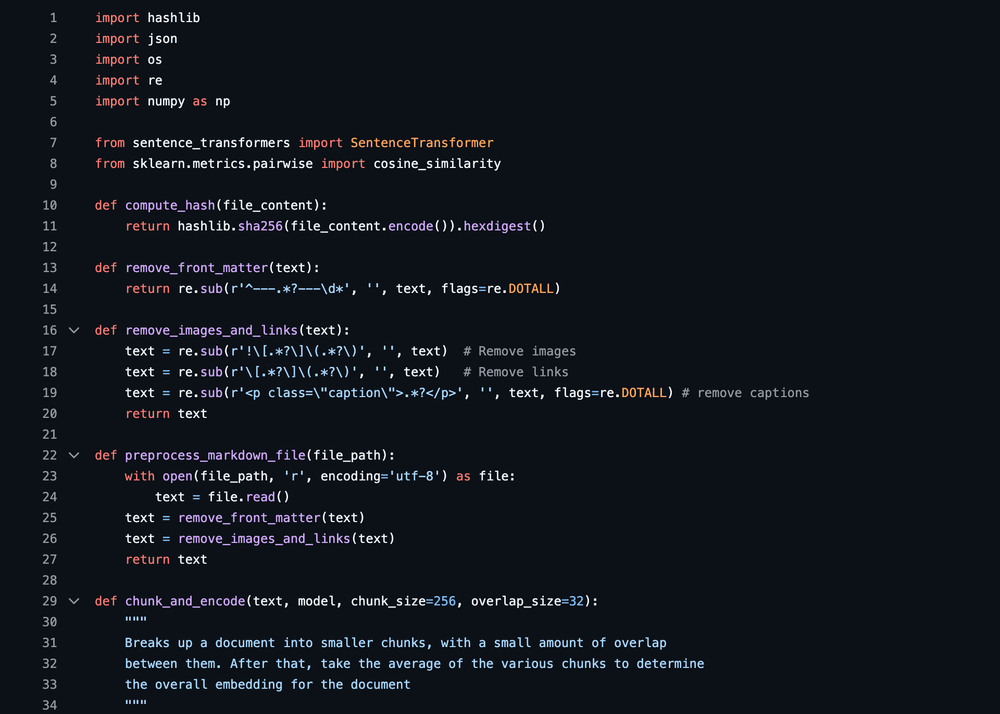
When a new developer starts on an existing project, the first thing they do is start reading through the code alongside any documentation that exists. They conceptually assemble all of the building blocks into a mental model that allows them to understand how the system is functioning. Sometimes the underlying logic lacks context or is so difficult to follow that the programmer will just put it in a mental black box labelled, “I think this function does X?” - but they aren’t sure, and will never tinker with it for fear of blowing everything up.
This process is similar to a builder doing a survey of a site to understand where the electrical, gas, and water pipes are before they start digging and potentially causing a lot of damage (or clean up).
Even with good development hygiene (good naming, logical models, comments, documentation, tests), developers will spend a significant amount of time mapping backwards from implemented code to their conceptual understanding of it so they can begin to reason about it. Once the programmer feels confident in their understanding they start to work out how they would change the system.
This is where I think an LLM AI partner can help improve this process.
LLMs are incredible translation tools. As we saw above, we can write some pseudocode to find the maximum number in a list and it produced code to do this. We added some conditions and it refined the code, and made some test cases to help validate it was working correctly.
We could use this same process to go the other way as well. We provide some code and ask the LLM to provide a pseudocode summary of that code. For example, using some existing code for a plugin I wrote for this site to build the pull quotes, we can generate the pseudocode and get an explanation about what is going on.
# This function looks for paragraphs in the markdown content and
# checks if they contain <b> tags. If a <b> tag is found, the
# paragraph is transformed into a special pull-quote section.
Function ProcessMarkdown(markdownAST, pluginOptions):
# Precondition: markdownAST is a valid abstracty syntax tree of markdown content
# Step 1: Go through each paragraph in the markdown content.
For each paragraph in markdownAST:
# set up some variables to keep track of the <b> tags
Set bfound = False
Set bindex = None
# Step 2: Look for a <b> tag within the paragraph.
For each element in the paragraph:
If the element is an HTML tag and is a <b> tag:
Mark that a <b> tag was found (bfound = True)
Remember where the <b> tag is located (bindex = its position)
# Step 3: If a <b> tag was found in the paragraph:
If a <b> tag is found:
# Find the text right after the <b> tag.
Set pullquote = the text inside the <b> tag
# Make the first letter of the pullquote capitalized.
Capitalize the first letter of the pullquote
# Replace any quotation marks in the pullquote
# with HTML-friendly quotes.
Change " characters to " in the pullquote
# Convert the entire paragraph into plain text for later use.
Set text = the full text from the paragraph
# Step 4: Create new HTML content for the paragraph.
Build a new paragraph element with the text
Add pullquote to the `data-pullquote` attribute of the paragraph element.
Add the `has-pullquote` class to the paragraph element
# Step 5: Replace the old paragraph with the new HTML.
Change the paragraph to be of type HTML and remove its original contents.
Replace the AST node with the new paragraph element.
# Step 6: Return the modified markdown content (markdownAST).
Return the updated markdownASTThis is a pretty good representation of what’s going on, and the steps link directly back to the implemented code. As well as our structured logical, model it’s possible to get an even higher level summary:
* Look for paragraphs in the markdown content.
* Check for <b> (bold) tags inside those paragraphs.
* If a bold tag is found:
* Extract the text right after the bold tag.
* Capitalise the first letter of that text.
* Format any quotation marks for safe HTML display.
* Replace the paragraph with a new HTML block that highlights the extracted
text as a pull-quote.
* Return the modified markdown content with these changes.This is excellent context for a new developer on the project, especially if they were still learning and weren’t sure what was going on.
Even using manual processes to move information between development tools and AI tools, this is helpful but in a more fully integrated environment this creates a huge amount of power very quickly.
Very quickly, I can see a reasonable summary of the code I’m working on and a side by side representation of the pseudocode and the executable code. Having all of this together starts to create some interesting opportunities for development.
With all of this in one place, and the AI tooling having a view of the code windows, edits in one location can get translated to another in realtime.

By editing the pseudocode, changes become reflected in the code base. This will help learners anchor their understanding on how the programming language functions. A more experienced developer may recognise a logic gap in pseudocode and address it, which immediately gets reflected in the underlying code.
Going the other way, making edits to the lower level executable code will result in the pseudocode getting updated in realtime. This means the code repository will always have a structured, logical representation of what the code is doing.
Most importantly, this structured, pseudocode representation will always be at whatever level of abstraction I am looking at. This could be a function, a class, a module or a whole file.
In a fully integrated environment, the system would maintain links between blocks of code which will improve code translation integrity as the LLM’s focus can be guided (it won’t be regenerating an entire function, just because a small edit was made in one part of it). An early peek at this future is already evident in Artifacts in Claude and Canvas in ChatGPT, but this is just the start.
As a result of this bidirectional flow of change and context matching, the barrier between what I do as a programmer and how I go about doing it begins to break down. The translation all gets handled in the system directly, and I can choose which level I want to engage with. As a developer using this system, I am likely to maintain a flow state more effectively and produce higher quality outcomes because I’m more directly solving problems in the most appropriate way.
This will bring with it some new edge cases. Notably this occurs when the changes made to pseudocode are incompatible with the underlying code. The development environment will need to surface this new type of error in a way that helps the developer reconcile these incompatibilities. Similarly, in very complex code that is harder to abstract, there is the potential for drift between the conceptual and executable code layers.
In either case, a developer may choose to opt out of realtime translation and work more directly in the executable code layer, then rebuilding the pseudocode at the completion of their work as a summarisation step instead (this could be incorporated into build tooling).
For some non-routine domains, the LLM AI tools may even have specialisations which can be added to the development environment to assist the programmer. This could be for applications that are more complex (such as gaming or distributed event driven systems) or where highly specific knowledge is required (such as finance, medicine or compliance systems).
Taking this to it’s logical conclusion, one can envisage an integrated environment where the tooling is also supporting the running of the executable code produced.
Great strides have been made in this area over recent years with embedded execution consoles in our IDEs and we’ve had live debuggers for decades. But all of this presupposes that the developer has got their environment up and running properly in the first place.

That process of environment set up is still a challenge - even for experienced developers starting a new project or landing in a very mature one, and this is even more challenging for a beginner. The number of beginners I’ve had come to a workshop with old versions of NodeJS or Python that cause huge conflicts because they don’t use virtual environments or containers is astonishing. It’s because they don’t know how to do it or even that it’s a valuable way to set up.
Imagine a scenario where some basic questions or an instruction to the AI tooling does the set up and configuration of a virtual development environment for you using sensible defaults that reflect a set of current best practices for developer experience, security, package management etc.
This would probably lean on existing tools like docker for portability, along with the ability to leverage great defaults, and a wide community base of developed images and be extended to run the generated code from the development environment. With tools like docker already integrated into most development flows, once you had an LLM integrated development tool, linking this part up would be comparatively straightforward.
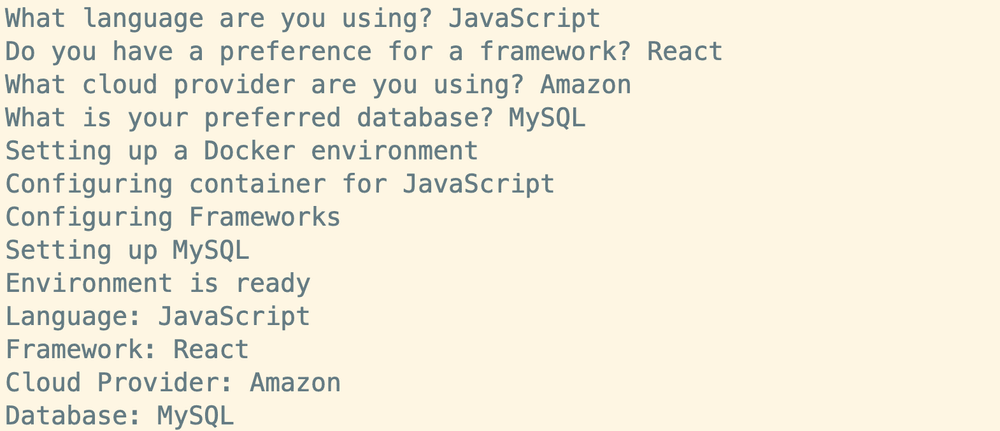
For developers in a bigger team, this process would leverage existing patterns for environment creation based on established DevOps guidelines set by the technology function of the business. This would be an enterprise-wide configuration - much like how organisations already use things like Amazon’s Well Architected Framework to have a sensible starting points and account landing zones that have good defaults across the pillars.
The final part of this advanced development environment would be to link the debugging process to AI tooling to support programmers.
Google has already released some limited tools in Chrome to help web developers debug front end code. It shows you potential reasons for the error and can even use the context of the running code from the browser and link that back into Gemini and Google Search to deliver a powerful debugging experience to a web developer. Just this week as I was writing this the Chrome team have extended this to allow prompting and styling assistance.
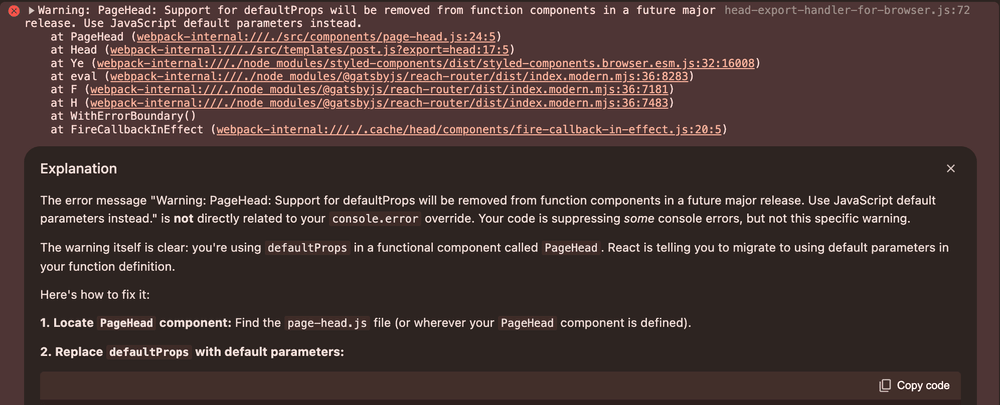
Building on these ideas, debugging can be augmented further by linking the errors through the low level code back up to the higher level pseudocode. This helps highlight the difference between errors such as type mismatches or syntax problems with logical bugs like off by one errors or side effects.
For learners, this will help them understand the nature of these issues so they can see how they manifest and the different ways to resolve them. For more experienced developers, this will speed them up considerably by helping them zero in on where the likely causes might be and identify the problems.
A development environment that provides realtime translation between the high-level, conceptual logic of pseudocode, and the lower level executable code would be a benefit for experienced and beginning developers alike. Add to this the ability to build and manage environments by answering a few questions, and bring to bear a more advanced debugging capability and this all starts to reshape what developer experience looks like.
For over 50 years, development environments have had a drip feed of enhancements that drive programmer productivity, however at their heart they are mostly a text editor with some auto-complete smarts, a window into a file system and a command line console. The integrations have got better, the autocomplete is smarter and we can change our fonts or flip to dark mode. A programmer starting university in 2024 or 2004 or 1974 would all have remarkably similar experiences of writing code into a text file and then getting the computer to run it.
This concept reimagines what development might look like. An AI-native approach to the development environment doesn’t do away with the text editor, but it does fundamentally change the way a programmer authors code and runs it - transforming the process from a series of discrete steps to one of partnership and dialogue between the developer, the AI and the code. In the final section, I’ll look at what a new model of development practice might look like.
A different model of development
Shifting toward a more AI-native model of development, that fundamentally rethinks the role of the programmer in the process and their relationship with their current tooling presents some interesting new opportunities for software development.
Using an integrated LLM AI as part of the workflow shifts from being a reactive tool that is essentially a glorified autocomplete (eg Copilot or even Chat GPT / Claude in 2024) to being a proactive development partner - where the tool is bridging multiple layers of abstraction and providing realtime translation under the direction of the developer (more like pair programming). As with all good partnerships, this is bidirectional - where the tool provides clear (deterministic) feedback on inputs, as well as contextual (inferential) insights to help improve the overall quality and clarity of the produced artefacts.
By taking an AI-native approach, many repetitive tasks can be pushed away from the developer. We already do this by using frameworks, libraries, utility functions and greater levels of abstraction and have done for decades. This allows developers to keep more time focussed on the tasks that are higher cognitive load and also more likely to be higher value. Utilising the LLM to do the raw production work at scale will keep the developer more “in the flow”, thinking about the problem they are working on and less likely to need to get tripped up by trivialities.

Because this interaction becomes a dialogue between developer and AI Assistant in realtime, constraints and assumptions will be expressed that can be used to immediately generate a wide ranging battery of tests to prove the validity of the code. Coupled with existing test automation processes, feedback can be provided in real time on performance and test completion. This will naturally lead to improved quality, but coupled with the other conceptual artefacts such conceptual models and logical pseudocode, taken together, these artefacts will raise the reasonability of the code base for future developers and other team members.
This changed model of creation is extremely empowering for learners and experienced developers alike.
Beginners establish a better understanding of the connection between concepts and executable code - which they need to learn to become successful programmers. More experienced developers get significant productivity improvements on the code output side of things, allowing them to use their brainpower to solve significantly more complex business problems - which leads to better organisational outcomes and value creation.
Risks and challenges of AI-native development
It is at this point that it’s worth noting some of the downside risks and potential flaws in this proposed development model.
The most obvious concern, and one we are already beginning to see is that developers start to become too dependent on AIs to write code. Some teams are already citing this problem and this isn’t just limited to junior developers using AI as a crutch.
Development is a memory based skill and like any other, it will atrophy through lack of use.
Junior developers are particularly prone to this. As they copy and paste code between Chat GPT or Gemini and their IDE without necessarily understanding the logic behind it - they are inherently focusing on speed to complete their tasks (see my opening points regarding output based KPIs). This potentially leads to security issues and leaving the developer entirely unable to reason critically about what the code is doing or any errors that occur.
Fundamentally, this is because the logical concepts of the problem are not being linked to the produced code. This is why I believe this process needs to be a realtime dialogue using structured methods like pseudocode to direct what is happening as it intuitively links these two sides together.
The other major concern with this model of development is whether the LLM AI can perform in all contexts. For a number of general domains is likely okay given the current crop of frontier models’ performance. That said, there are undoubtably a number of complex domains - particularly in finance, medicine and engineering that have extremely specific rules, algorithms and compliance requirements and the Developer Assistant will simply be at a loss for what approach to take.
Fine tuning of the models or “plugins” that are used to hand off specific scenarios to dedicated “specialist AI” components for domain specific needs could be ways this problem is addressed. This would involve referencing other sources of trust such as required compliance checks in finance or diagnostic rules in medicine. These models will also need to be maintained to ensure alignment with evolving standards - especially those related to compliance needs.
This is being viewed very much through the lens of current 2024 LLMs however, and as has repeatedly been noted, these models are the least advanced AI will ever be. So with time, perhaps generalised future models will have a sufficient grasp of domain complexity that they will be able to perform acceptably.
Regardless, this is likely to be a challenge for the foreseeable future so methods for either hand off or being able to call internal APIs that “package up” compliant methods consistently may be ways to address this particular issue. This latter approach is no doubt already widespread as it assists with audit, compliance and consistency anyway.
Not Developer vs AI, Developer plus AI
This model of development that I’ve outlined unfortunately doesn’t currently exist as of October 2024, but the ways we see developers embracing LLM AIs, code generation tools and Co Pilot-like assistants give pointers towards future opportunities to rethink how software engineers work.
Research shows us that developers are only spending about a third of their time actually writing code. Another third of their time is spent doing “toil work” - writing tests, doing documentation, debugging, or maintaining code. The final third is largely meetings and other orchestration activities relating to collaboration.
Even using an output-centric approach for assessing potential productivity gains, the AI-native model of development I’ve proposed would be a benefit. Improved code-generation would increase developer productivity, and improved automation would decrease the toil work on an average developer. This would create a virtuous circle - creating more developer time that could be spent on creation which would then be completed at higher velocity.
But, more code output doesn’t necessarily result in better outcomes.
My view on this cycle of improvement due to AI-native development is that removing some of the code and artefact generation from the developer will allow them to spend more time thinking about and solving higher value problems. More time available for creation and problem solving, backed up by a robust AI development partner that can do a sizeable chunk of the code creation, will allow developers to spend more time working through much more difficult challenges.
Over time, this approach will yield competitive advantages for organisations that can deploy their developer capital towards these more challenging problems. It will also lead to greater innovation opportunities as developers are less constrained by putting out fires, testing or time-consuming maintenance. It’s hard to innovate when you’re constantly doing hygiene activities.
I feel very optimistic about the opportunity that is beginning to manifest as I look at the potential combination of developers augmented by AI partners.
Right now, AI is already being used by engineers and while some are using it effectively and collaboratively, it’s somewhat disconnected from our core tooling. This results in lots of copy-pasting between systems which slows developers down and potentially presents security risks. But the desire is clear.
By leveraging the power of an LLM to provide realtime translation between two points, there is an interesting opportunity to be able to partner the developer and AI assistant to go between the high level conceptual logic and the low level executable implementation seamlessly. Augmenting this further via bidirectional translation between the layers, realtime feedback loops, automated test production and ability build and run development environments and this fundamentally changes the developer experience.

By bringing this all together into a new, AI-native approach to software development, this could result in truly significant productivity improvements, more creative problem solving and we enable more of our global software engineering talent to work on harder problems. This could also act as wayfinding for other professions who will follow behind software engineers and need to look for patterns of integrating human and AI capabilities together.
There is some way to go from our current development methods in 2024 to the future I’ve outlined in this essay, however I think we’re on track to seeing something like this become feasible in the next few years. And there will be the need too.
This will be driven by the next wave of digital and AI transformation in business, yet again requiring more software engineering talent than the world produces, and the inexorable process of automation that all developers embrace to help improve productivity.
Software engineers have always been forced to embrace change in working methods and this transition to AI-native ways of working will prove no different. The process itself will be uncertain, undoubtably with false starts and false promised, but on the other side, there are some big opportunities to tackle significant problems ahead.
If you’re working on something like what I’ve described as AI-native development, or have insights or similar challenges as I’ve discussed, or are curious about this journey, reach out - I’d love to connect and share perspectives on this topic or potentially support your efforts.
